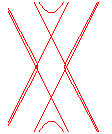Algebraic curve iff n is rational.
| next curve | previous curve | 2D curves | 3D curves | surfaces | fractals | polyhedra |
POLYGASTEROID
| Name given by Loria in 1930 [Curve
piane speziali algebriche e trascendenti, vol I, page 497].
Other names: curve with n antinodes, or curve with n overhangs ( Laboulaye, 1849), generalized conic (Mamikon, 2012). |
| Polar equation: Algebraic curve iff n is rational. |
| The polygasteroids are the inverses of the
conchoids
of roses.
They also are the conical projections of cylindric
sine waves on a plane perpendicular to the axis of the cylinder, when
the centre is on the axis.
|

Conchoid of a rose in blue, polygasteroid in red |
  |
Remark: the "monogasteroids" (n = 1) are none other than the conics. Therefore, the polygasteroids are the Brocard transforms of conics with respect to one of their poles.
The curve is composed of a base pattern symmetrical about
Ox,
obtained for :

base pattern for e < 1 |

base pattern for e = 1 (parabolic branch) |

base pattern for e > 1 (branch with asymptotes) |
transformed by all the rotations by ,
when k is an integer.
When n is rational and its numerator is p,
p rotations generate the whole curve.
Case e < 1: we get shapes similar to inverse
conchoids
of roses.
For n = p / q, the polygasteroid with parameter
n
is one of the possible projection of the
Turk's
head knot of type (p,q); its p external vertices and
its p internal vertices form a regular polygon, and it has
p(q
– 1) double points.

n = 1: ellipse |

n = 2: Booth oval |

n = 3 |

n = 4 |

n = 5 |

n = 1/2 |

n = 3/2 projection of the trefoil knot |

n = 5/2 projection of the 5.1 knot |

n = 7/2 |

n = 9/2 |

n = 1/3 |

n = 2/3 projection of the eight knot |

n = 4/3 projection of the 8.18 knot |

n = 5/3 projection of the 10.123 knot |

n = 7/3 |

n = 1/4 |

n = 3/4 projection of the 9.40 knot |

n = 5/4 |

n = 7/4 |

n = 9/4 |

n = 1/5 |

n = 2/5 |

n = 3/5 |

n = 4/5 |

n = 6/5 |
Case e = 1 : equation becomes
(compare to the epispirals
).

n = 1: parabola |

n = 2: Kampyle of Eudoxus |

n = 3 |

n = 4 |

n = 5 |

n = 1/2 |

n = 3/2 |

n = 5/2 |

n = 7/2 |

n = 9/2 |

n = 1/3 |

n = 2/3 |

n = 4/3 |

n = 5/3 |

n = 7/3 |

n = 1/4 |

n = 3/4 |

n = 5/4 |

n = 7/4 |

n = 9/4 |

n = 1/5 |

n = 2/5 |

n = 3/5 |

n = 4/5 |

n = 6/5 |
Case e > 1:

n = 1: hyperbola |

n = 2 |

n = 1/2 |

n = 3/4 |
The polygasteroids are the planar expansions of the planar section of the cone of revolution.
If the plane of the conic
is winded into a cone
with vertex O, half-angle at the vertex
,
and axis Oz, then the projection on xOy of this winded conic
is the polygasteroid
,
which provides a construction of the latter in the case n < 1.
These curves can also be obtained as the mating profile of a line.
The evolutes of the tractories
of circles as well as the projections on the symmetry plane of the
rhumb
lines of the open torus are polygasteroids.
| next curve | previous curve | 2D curves | 3D curves | surfaces | fractals | polyhedra |
© Robert FERRÉOL 2024